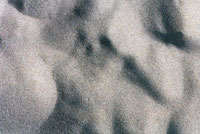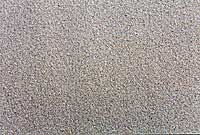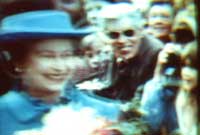|
Cornish Textures
This is a pretty stupid page. (Alternatively, it is a canny and perceptive photo-essay.) What I have done is go around taking pictures of surfaces in Cornwall. The result is a load of images that might be interesting, might work as background images on your webpage, might be a sort of entertaining gallery of objets trouvées, or might just be a waste of webspace. However, in that last instance, I console myself that there are far worse culprits than myself when it comes to wasting webspace. So take a look at my surfaces and textures, and enjoy.

|
This is genuine Godrevy sand, untouched by human hand or foot, and untouched by seawater for quite a while. This sand is as dry as a bone. However, there is no guarantee that it will remain dry. Yet while it is, it is completely unsuitable for building sandcastles.
|

|
I told you there were no guarantees. This is the same article: genuine Godrevy sand, but the picture was taken just a few minutes after the other. The seawater advanced, then it receded. Wet sand was the result. You can see that it is marginally damper at the bottom of the photo. It is details like these that make reputations.
|

|
Just a few miles to the east, at Portreath, this rock, like a million others in Cornwall, is slightly encrusted with lichen. Some rocks are heavily encrusted with lichen but, as this is a family site, I decided to omit my large collection of photographs.
|

|
Quite a lot of the south coast of Cornwall is covered in pebbles instead of the fine sand that tourists favour. These pebbles were noticed on the beach at Long Rock, just outside Penzance. Long Rock is also famous for its supermarket, its railway depot, and its bus stop at which no bus ever seems to stop. Particularly if you are trying to go to Helston.
|

|
About six miles to the north, at Lanyon, some gorse. Gorse is also known as furze. In Germany they call it 'Ginster'. By chance, 'Ginster' is also the name of a brand of Cornish pasty (export only: they're not much like the real thing so the Cornish tend to leave them alone). Gorse flowers smell of coconut, strangely, unlike Cornish pasties, which smell of beef and turnip.
|

|
On a hillside at Carnmenellis, near Four Lanes, near Redruth, some grass. When I was a child and erroneously said 'ay?' instead of 'pardon?', relatives said: 'don't say "ay", "ay" is wot orses eat'. The difference between grass and hay is colour, and here we see the green of grass magnificently transmutating into the yellow of hay. And not an orse in sight.
|

|
Unlike the other images, this one is artificial. It is the dome of the Eden Project. Ruskin said of Sir Joseph Paxton, the designer of the Crystal Palace, that he wished only "to build greenhouse like no greenhouse was ever built before". Ruskin was a snob, and Paxton would have been proud of the Eden Project.
|

|
The Funny Vicar: A Cornish institution of the 1970s and 80s. Each evening, the local TV station, Westward TV, would close down with a patriotic video of the Queen on walkabout in Plymouth, accompanied by the National Anthem. Each evening, this Dick Emery lookalike would momentarily flash onto the screen. Tim Watters took this photo from the TV screen (a Cornish surface, I argue). I don't know who owns copyright on the video sequence, but I'd be happy to add your name (or remove the image) if you get in touch.
|
* This page last updated 29 August 2003 *
|







